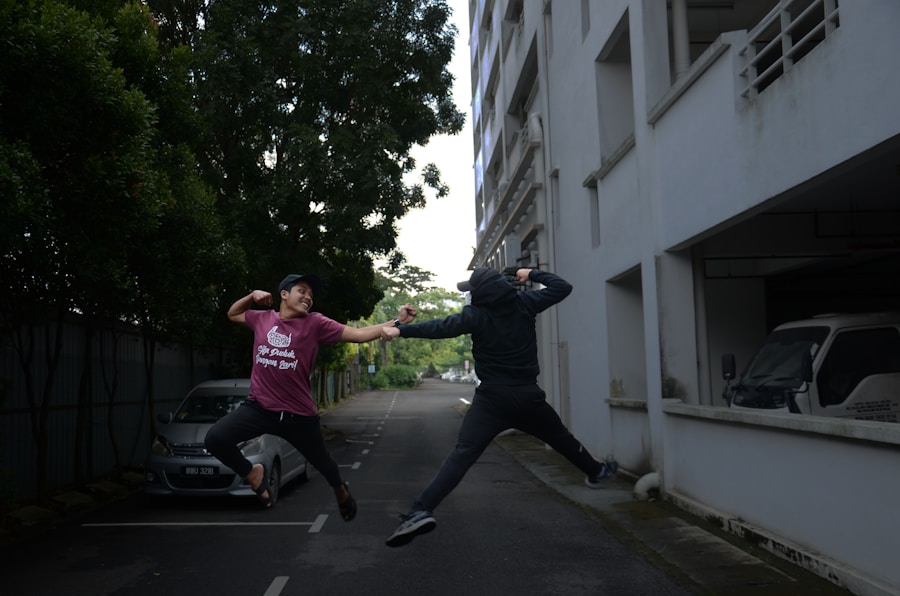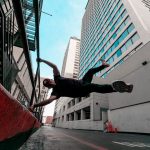Download links
How to install Mastering Parkour with taya773: The Ultimate Guide APK?
1. Tap the downloaded Mastering Parkour with taya773: The Ultimate Guide APK file.
2. Touch install.
3. Follow the steps on the screen.
Description
Parkour, often described as the art of movement, has its roots in the late 20th century, emerging from the streets of France. Its origins can be traced back to the 1980s when a group of young practitioners, inspired by the military training methods of Georges Hébert, began to explore urban environments in innovative ways. Hébert’s philosophy emphasized natural movement and efficiency, advocating for a holistic approach to physical training that included running, climbing, and jumping.
This foundational ethos laid the groundwork for what would evolve into parkour, a discipline that celebrates fluidity and creativity in navigating obstacles. The term “parkour” itself was coined by David Belle, one of the discipline’s pioneers, who sought to encapsulate the essence of this movement practice. Belle and his contemporaries viewed parkour not merely as a physical activity but as a philosophy of life.
They embraced the idea of overcoming obstacles—both physical and metaphorical—through determination and adaptability. This perspective is deeply embedded in the culture of parkour, where practitioners often refer to themselves as “traceurs” (male) or “traceuses” (female), emphasizing their commitment to continuous self-improvement and exploration. The philosophy of parkour extends beyond mere athleticism; it encourages individuals to confront their fears, push their limits, and cultivate resilience in the face of adversity.
Key Takeaways
- Parkour originated in France in the 1980s as a training discipline using movement developed from military obstacle course training.
- The philosophy of parkour emphasizes self-improvement, overcoming obstacles, and efficient movement through the environment.
- Essential parkour techniques include running, jumping, climbing, and balancing, with an emphasis on fluidity and adaptability.
- Training tips for parkour include practicing basic movements, building strength and flexibility, and gradually progressing to more challenging environments.
- Overcoming mental and physical challenges in parkour requires focus, determination, and the ability to assess and mitigate risks.
Essential Parkour Techniques and Movements
Mastering the Precision Jump
For instance, the precision jump is a critical technique that involves leaping from one surface to another with accuracy, requiring both strength and control. This skill is essential for traversing gaps between buildings or landing on narrow ledges.
Vaulting Techniques for Efficient Obstacle Clearance
Vaulting is another cornerstone of parkour, encompassing various styles such as the speed vault, lazy vault, and kong vault. Each vault technique is designed to help practitioners overcome obstacles like railings or walls efficiently. The speed vault, for example, allows a traceur to maintain momentum while clearing an obstacle, making it particularly useful in fast-paced environments.
Climbing and Ascending with Safety and Creativity
Additionally, climbing techniques are vital for scaling vertical surfaces, whether it be a wall or a tree. The ability to ascend and descend safely is crucial for any parkour practitioner, as it opens up new avenues for exploration and creativity in movement.
Training Tips and Exercises for Parkour

Training for parkour requires a multifaceted approach that combines strength, agility, flexibility, and mental focus. One effective way to build strength is through bodyweight exercises such as push-ups, pull-ups, squats, and core workouts. These exercises not only enhance physical capabilities but also mimic the movements encountered in parkour.
For instance, performing explosive push-ups can improve upper body strength essential for vaulting over obstacles. Incorporating plyometric exercises like box jumps can further develop explosive power, which is crucial for executing high jumps and dynamic movements. In addition to strength training, agility drills play a significant role in parkour preparation.
Ladder drills, cone sprints, and agility hurdles can enhance foot speed and coordination. Practitioners should also focus on flexibility through dynamic stretching routines that target key muscle groups used in parkour movements. Yoga or dedicated stretching sessions can improve overall mobility, reducing the risk of injury while allowing for more fluid movement during practice.
Furthermore, incorporating balance exercises—such as walking along narrow beams or practicing on uneven surfaces—can enhance stability and control when navigating obstacles.
Overcoming Mental and Physical Challenges in Parkour
| Challenges | Percentage of Parkour Practitioners |
|---|---|
| Fear of Heights | 45% |
| Strength and Endurance | 60% |
| Flexibility and Mobility | 30% |
| Concentration and Focus | 50% |
| Injuries and Recovery | 25% |
Parkour is as much a mental discipline as it is a physical one. Many practitioners face psychological barriers that can hinder their progress. Fear of falling or injury is common among beginners and can be paralyzing when attempting new moves or heights.
To overcome these mental challenges, it is essential to adopt a gradual approach to training. Practitioners should start with smaller obstacles and progressively increase difficulty as they build confidence.
Moreover, fostering a supportive community can significantly impact one’s mental resilience in parkour. Training with others provides encouragement and motivation while creating an environment where individuals feel safe to take risks. Sharing experiences and learning from one another can help demystify challenging movements and instill a sense of camaraderie among practitioners.
Additionally, mindfulness practices such as meditation can enhance focus and reduce stress levels, allowing traceurs to approach their training with a clear mind.
Safety Precautions and Injury Prevention in Parkour
Safety is paramount in parkour training, given the inherent risks associated with high-impact movements and urban environments. Practitioners should prioritize proper warm-up routines before engaging in any physical activity to prepare their bodies for the demands of parkour. Dynamic stretches targeting major muscle groups can increase blood flow and flexibility while reducing the likelihood of strains or sprains during practice.
Another critical aspect of injury prevention is learning how to fall safely. The roll is a fundamental technique that allows practitioners to dissipate impact forces when landing from jumps or falls. Mastering this skill can significantly reduce the risk of injury during training sessions.
Additionally, wearing appropriate footwear with good grip can enhance stability while minimizing slips or falls on various surfaces. Practitioners should also be mindful of their surroundings; assessing obstacles for safety before attempting any movement is crucial in preventing accidents.
Taking Parkour to the Next Level: Advanced Tips and Tricks

For those looking to elevate their parkour practice beyond the basics, advanced techniques offer exciting opportunities for growth and creativity. One such technique is the cat leap, which involves jumping towards a wall or ledge while extending the arms forward to catch oneself securely. This move requires precise timing and spatial awareness but can be incredibly rewarding once mastered.
Practitioners can also explore variations like the wall flip or wall spin, which add an acrobatic flair to traditional movements. Incorporating flow training into practice sessions can further enhance one’s skills in parkour. Flow training emphasizes seamless transitions between movements, allowing traceurs to navigate obstacles fluidly without interruption.
Practitioners can create obstacle courses that challenge them to connect various techniques in succession, fostering creativity and adaptability in their movement patterns. Additionally, exploring different environments—such as parks, urban settings, or natural landscapes—can inspire new ideas for movement sequences while broadening one’s understanding of spatial dynamics. As practitioners advance in their skills, they may also consider participating in workshops or training camps led by experienced traceurs.
These events provide valuable insights into advanced techniques while fostering connections within the parkour community. Engaging with seasoned practitioners can offer fresh perspectives on training methodologies and encourage individuals to push their boundaries further than they thought possible. Ultimately, taking parkour to the next level involves a commitment to continuous learning and exploration within this dynamic discipline.
FAQs
What is parkour?
Parkour is a physical discipline that involves moving through an environment in a creative and efficient way, using only the human body and the surroundings to propel oneself.
Where did parkour originate?
Parkour originated in France, developed by David Belle and his group of friends in the late 1980s. It was inspired by military obstacle course training and various physical disciplines.
What are the basic movements in parkour?
Basic movements in parkour include running, jumping, climbing, vaulting, and balancing. These movements are used to navigate obstacles and terrain in a fluid and efficient manner.
Is parkour dangerous?
Parkour can be dangerous if not practiced with proper training and safety precautions. It is important to start with the basics and progress gradually to more advanced movements.
Can anyone do parkour?
Parkour is accessible to people of all ages and fitness levels, but it requires dedication, discipline, and proper training. It is important to start with the basics and progress gradually to more advanced movements.
Are there any specific clothing or gear required for parkour?
While there is no specific clothing or gear required for parkour, it is recommended to wear comfortable and flexible clothing that allows for freedom of movement. Some practitioners may choose to wear gloves for grip and protection.





